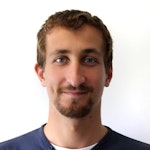Ivan Nikitski: What’s the story behind co-founding Quantopticon?
Mirella Koleva: In 2008, after graduating with a masters in physics from Imperial College London, I decided to explore the crossover of physics with other sciences. Accordingly, I embarked on a Ph.D. on super-resolution imaging, building a state-of-the-art microscope and using it to study a protein of monumental biomedical significance called Sonic hedgehog. I followed this in 2014 with postdoctoral research broadly along the same lines, first at the University of Oxford, then at King’s College London.
Shortly after starting at Oxford, Gaby Slavcheva, who happens to be my mother, told me she’d developed some comprehensive computer code that could model quantum-photonic processes and phenomena accurately and completely. This was a real breakthrough because it solved the problem of designing and optimizing the quantum characteristics of photonics devices, which at that time could only be done by carrying out multiple experiments that were wasteful, inefficient, and expensive.
I was immediately attracted by her exciting achievements and decided to help her to commercialize her technology and turn it into a worthwhile software product. To this end, in 2017, we co-founded Quantopticon with the goal of creating the world’s first design software platform for quantum-photonic devices.
IN: How has the company evolved?
MK: We started planning Quantopticon while I was at the University of Oxford and my mother was at the University of Bath. Then, in 2017, a few months before I moved back to London to work as a postdoctoral research associate at King’s College London, we formally set up the company. We were both reluctant to abandon the relative comfort of academia, so we only worked on the company part-time without either of us having any defined roles.
Things moved slowly and, by 2019, it became apparent that to be successful, we needed to commit ourselves to Quantopticon full-time. It made sense for her to take on the role of chief scientific officer and for me to become CEO. We could have created a spinout from the University of Oxford, but we decided against it.. Consequently, we remained independent of any university, although we recently became affiliated with the University of Chicago, who were generous and supportive, offering us free membership to the Chicago Quantum Exchange Program which connects startups with academics, government labs, industry, investors and other stakeholders around the city, and beyond. We now have two branches of the company: one in the U.K. and one in the U.S., so we’re now a multinational startup.
From the start, we’ve had a IT manager working part-time, and early on we hired a software engineer to develop our user interface. We’ve had interns working for us for a couple of months at a time, but last year we onboarded two full-time technical employees who are based in Chicago.
IN: What were the challenges in setting up Quantopticon?
MK: The main problem was the absence of any similar companies we could model ourselves on, which meant we had to work things out on our own, with help and advice from our network and the photonics ecosystem. For instance, we sought advice about how we should present ourselves, how we should talk about our product, and spent copious amounts of time researching different ways customers would use our software. We also obtained advice about milestones we ought to reach to be attractive to investors and persuade research groups to try out our software. The other problem was not having the backing of a university tech transfer office behind us to offer an extra pair of hands in filing patents and helping to promote the business. Similarly, not having our own research group meant we couldn’t easily source talent.
IN: Who are your main customers and what is your main source of income?
MK: Currently, our main customer is the European Space Agency (ESA), which commissioned us to develop high-quality, high-specification single-photon sources for satellite quantum communications. These sources must be invulnerable to eavesdropping attacks, with a large bandwidth to enable the distribution of quantum keys at a very high rate. On this project, we are computing not just the optimal design blueprint of the single-photon source but are also coordinating our long-standing collaborators at the Technical University of Munich and the University of Oxford to manufacture the physical device. These single-photon sources will be integrated into one of the successors of Eagle-1—Europe’s first quantum encryption satellite—in accordance with the SAGA mission spearheaded by ESA. The SAGA (security and cryptographic) mission’s objective is to launch a constellation of satellites into orbit for the purpose of establishing quantum-secured long-distance communication.
The ESA is one of our main sources of income, and we also have investors from New York State. In fact, we’re now partly owned by the state of New York as a result of their state funding program.
IN: What’s the distribution model of your software?
MK: Our software suite, Quantillion, can be used for a diverse range of applications including quantum-photonic memories, quantum light sources, quantum-photonic logic, and even vertical-cavity surface-emitting laser (VCSEL) dynamics. We have a standalone minimum viable product (MVP) in the form of a desktop application that users can install on their own machine—preferably a high-end workstation to guarantee short simulation runtimes. This has worked okay so far, but we think it will make their lives easier if we offer our software through the cloud or make it browser accessible, instead of having to go through the hassle of installing it on their own computers. In any case, we intend to keep the standalone version of Quantillion within our product offering.
IN: What are the main markets for future growth?
MK: We can model quantum-photonic components—everything from single-photon, entangled or multiphoton sources up to, but excluding, the sensor. This includes all of the intermediate quantum information processing components, like beamsplitters, modulators, and waveguides. Moreover, we can predict the coupling of photons into and out of these components and minimize insertion, coupling, and transmission losses.
Our future goal is to be able to model entire integrated circuits to facilitate the design and integration of quantum-photonic components onto a chip—helping to miniaturize these systems and make them field-deployable.
IN: How do you envision Quantopticon in the future?
MK: We want to build and grow a substantial company and produce our own blueprints to sell directly to customers. Certain types of devices are very popular, so we plan to generate optimized designs customers will be able to buy off the shelf, rather than having to use our tools to produce them. Notwithstanding, we also plan to have our computer-aided design tools available on a subscription basis if customers want something custom. We also plan to integrate our software into the workflows of semiconductor foundries, because many of them are orienting themselves toward mass production of quantum-photonic components for quantum computers and quantum communication infrastructure. We have the know-how to enable them to mass produce these devices efficiently, to minimize waste and drastically reduce costs.
One of our main challenges going forward is to show customers what we can do. By definition, an MVP has very restricted applications, so we need to find the perfect customer who can use our software for their purposes right now. We aspire to demonstrate a 10-fold reduction in the design cycle length, and a 10-fold decrease in associated expenses, since customers will be able to avoid testing and rebuilding device prototypes. This is more challenging than anticipated, but we are exploring various routes such as talking to manufacturing institutes in the U.S. as well as a few large enterprises in the U.S. and Europe. We’re also applying for public grants with research groups and companies in Europe.
IN: If you started again, what would you do differently?
MK: In the beginning, I was too cautious, not wanting to leave the relative comfort of academia. If I could start again, I would just dive straight into the company working full-time from day one, rather than splitting my time between the company and being a research postdoc!
IN: What’s your advice for the next generation of entrepreneurs?
MK: If you are an innovator, there’s a point in your career where you have to decide which way you want to go: to remain a research scientist or run a startup. It’s not feasible to do both, unless you have an enormous team that can help you drive the company forward. Most people start with a very small team, and it requires a lot of commitment and dedication, so I think it’s better to make your decision sooner rather than later.

